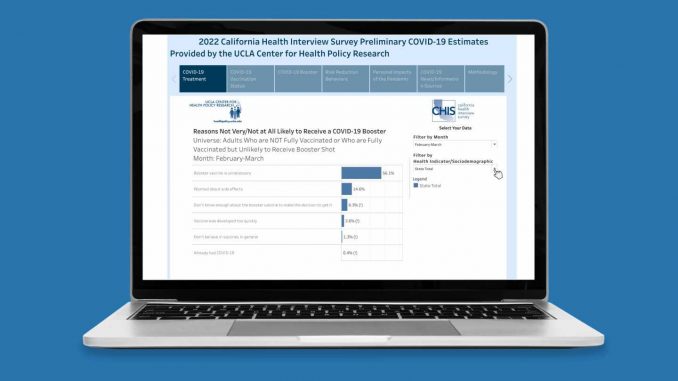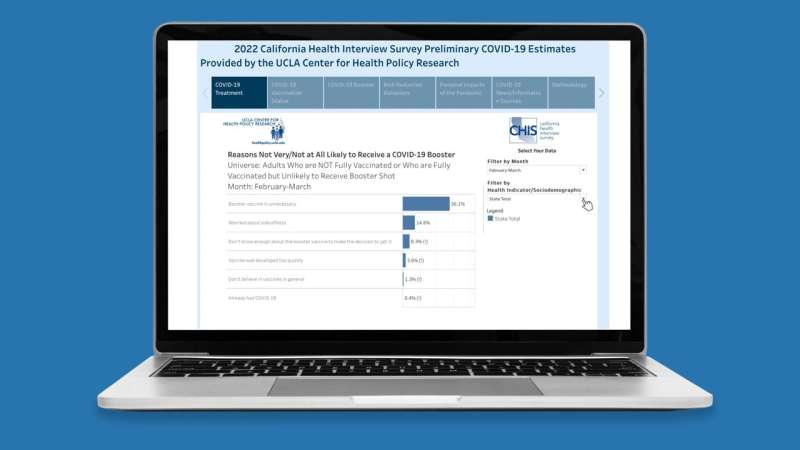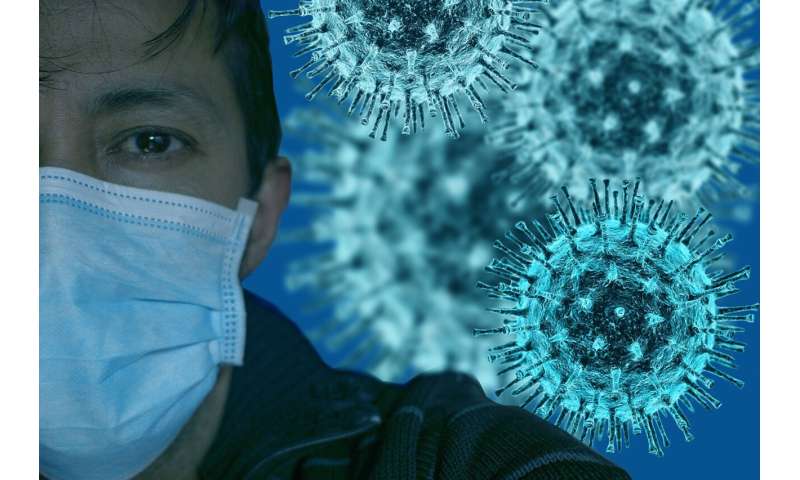

Despite the U.S. Food and Drug Administration’s full approval of the COVID-19 vaccine, 58.8% of Californians who are not fully vaccinated are still worried about its side effects, according to a new UCLA survey.
The finding is among the results of the 2022 California Health Interview Survey Preliminary COVID-19 Estimates Dashboard, published today by the UCLA Center for Health Policy Research.
The survey also found that of Californians who are either unvaccinated or partially vaccinated, 41.0% haven’t gotten the vaccine because they believe it was developed too quickly and 30.0% said that they believe the vaccine is unnecessary.
And of Californians who were not fully vaccinated or had received the vaccine but would not get boosted, 56.1% said they believe the booster is unnecessary.
The dashboard, which uses data collected from 3,752 households in February and March, includes new insights about Californians’ experiences with long-lasting COVID-19 symptoms, as well as respondents’ reasons for not receiving the vaccine or booster shots, and where they obtained their news about COVID-19. The survey also delved into the personal and financial effects of the pandemic, and whether and how Californians adhered to recommended risk reduction behaviors, such as wearing masks and following guidelines on social gatherings.
“Since the start of the COVID-19 pandemic, the California Health Interview Survey has released survey data early to help show the impact of COVID-19 on Californians,” said Todd Hughes, the survey director. “As mandates, guidelines and concerns have changed over the past two years, we have added new questions to CHIS to provide policymakers, community organizations, advocates and other stakeholders with data they can act on.

“The dashboard gives us a chance to compare behaviors over time, and to take a look at who is affected by the pandemic, and how, as we venture into its third year.”
Among adults who had tested positive for COVID-19, or who thought they had contracted the disease, 30.9% said they had experienced symptoms for two months or longer, often called long COVID. Of those who have asthma, diabetes or high blood pressure, 38.8% experienced long-lasting symptoms, while 26.4% of people who do not have such conditions had long COVID. The researchers also found that long COVID was more common among lower-income adults.
The survey suggests that Californians’ sources of news and information about COVID-19 plays a role in whether they decide to follow government officials’ advice about getting booster shots and following safety guidelines. Only 12.1% of California adults turned to government agencies for their COVID-19 information. The most common resources were television (cited by 32.9% of respondents) and social media (19.0%).
The percentage of unvaccinated adults who said social media was their main source of information was 30.8%, while just 17.9% of fully vaccinated adults said social media was their top source.
Other highlights:
- Financial consequences. 16.5% of adults reported a reduction in their work hours or income, 11.9% experienced financial difficulties with basic necessities—including paying bills, tuition and groceries—and 11.2% had lost their jobs due to layoffs, business closures or changes in the market.
- Racial and ethnic bias. 9.8% of Asian adults reported having been treated unfairly during the pandemic because of their race or ethnicity, compared to 3.0% of all respondents.
- Mask use. 44.3% of adults with bachelor’s degrees and 48.5% of those with graduate degrees said they always wear a mask when leaving home, compared with 78.7% of adults who have less than a high school education. Mask use also varied by region: 61.6% of Los Angeles County residents said they always wear a face covering, while just 36.5% of adults in the Northern/Sierra region said they do.
- Large gatherings. 9.4% of adults said they had participated in indoor gatherings with more than 1,000 attendees or outdoor events with more than 10,000 attendees within the past 30 days.
Source: Read Full Article